Working in product sometimes makes you feel like you’re a character in a Dungeons and Dragons game. So let me introduce you to the realm of user acquisition by being your dungeon master.

As the sun dipped below the horizon, casting a warm glow over the city, the adventuring party of app developers gathered around a small café table, eagerly discussing their latest creation. With months of tireless effort and countless cups of coffee, their digital product was finally ready to take Eberron by storm. Excitement filled the air as they brainstormed ways to reach a wider audience, attract new users, and propel their app to the top of the charts.
Little did they know they were about to embark on a journey of discovery — one that would introduce them to the enigmatic realm of user acquisition.
Like many others before them, they were about to learn that building a remarkable product was only the first step toward success. To truly thrive and defeat the competitive landscape, they needed a solid strategy to acquire and engage users, turning casual visitors into loyal customers.
In this guide, we’ll explore the world of user acquisition and examine various strategies that help products make a lasting impact in the hearts and minds of their target audience. From organic growth to paid advertising, from viral campaigns to influencer partnerships, we will uncover the secrets that transform promising products into flourishing ventures.
So grab your coffee, pick your armor, and get ready to uncover the captivating world of user acquisition — a journey that holds the key to unlocking digital success.
User acquisition is the process of attracting and converting new users to a product or service, with the goal of expanding the customer base and driving growth. This strategy involves leveraging various marketing channels, techniques, and analytics to optimize campaigns and achieve a higher return on investment (ROI).
Understanding user behavior, preferences, and needs enables product managers to create targeted marketing efforts that effectively engage potential customers and encourage them to adopt the product or service.
The importance of user acquisition in apps and digital products’ growth and success cannot be overstated. In fact, it is arguably the most critical aspect of any product’s growth strategy. There is a decent chance that your digital product is in a highly competitive market, so user acquisition plays a crucial role in standing out from the crowd. Without a steady flow of new users, you are unlikely to succeed in the long run.
User acquisition involves a range of activities, including marketing, advertising, and promotion. These activities are designed to attract new users and encourage them to use your product. Once they reach their aha moment, you have a great chance to convert them into loyal customers through engagement and retention strategies.
So how do you acquire users? Where, when, and how do you reach out to them? This is where user acquisition channels come into play. User acquisition channels are the various methods through which you acquire new customers:
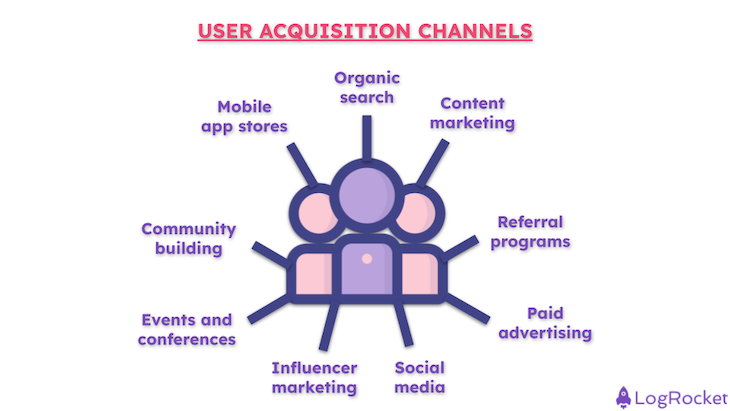
The effectiveness channel of each depends on a range of factors, such as the product itself, your target audience, and the competition. A successful user acquisition strategy involves a combination of channels tailored to the product and audience.
Let’s have a look at nine of the most common user acquisition strategies:
Users find your product through search engines like Google and Bing. Organic search is the most effective user acquisition channel, as users who find a product through search engines are often highly engaged and have a high intent to use it.
Warning: you’d better bring your SEO A-game here if you want to be successful.
Focus on creating valuable content that attracts users to your product. Customers are more likely to engage with a product that provides value beyond its core offering. It also helps you be more successful in your organic search efforts, with great content helping you improve your SEO.
Referral programs are designed to incentivize your existing users to refer friends, family, and others to use your product. This can be effective because people are more likely to trust recommendations from others.
Prominent examples of paid advertising channels include Google Ads and Facebook Ads. While this strategy can be effective, you need to be clear about the budget you want to allocate, as it can get expensive quickly and the return on investment (ROI) may not be as high as other channels.
Platforms like Facebook, Instagram, and Twitter can be powerful user acquisition channels. They enable you to provide targeted advertising and allow you to reach specific demographics.
Influencer marketing involves partnering with influencers to promote your product. It’s similar to a referral program but tends to be more expensive. While it can help you reap the rewards of reaching specific demographics, it tends to be costly.
You might consider attending or hosting events and conferences to acquire new users. This channel allows you to showcase your product and benefits to a captive audience of potential customers.
Attending events and conferences also provides an opportunity to network with other businesses and industry professionals. Hosting one can be particularly effective as it allows you to control the messaging and experience. It is especially useful when your product caters to niche audiences or industries.
Aim to create a community around your product through social media, forums, and other channels. This allows you to engage with users and customers on a deeper level, building trust and loyalty.
As a bonus, building a community enables you to gather insights into what your customers are expecting from your product next and how they are experiencing it.
Whether your product is a mobile app or a mobile version of an existing app, making your product available in app stores like Apple App Store and Google Play Store can be an effective way to attract new users.
As mentioned earlier, in today’s digital age, you have a plethora of user acquisition channels available to you. As mentioned above, two main categories are organic and paid user acquisition:
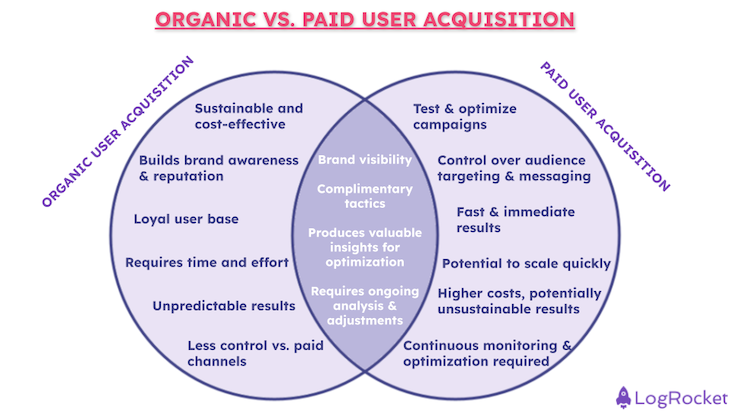
Each has its own set of advantages and disadvantages, and you must consider these tradeoffs when selecting your approach to user acquisition:
Organic user acquisition is the process of acquiring new users through unpaid or natural channels, such as search engines, social media, referrals, and content marketing. It is typically a more sustainable and cost-effective approach to user acquisition in the long run but requires consistent effort to create valuable content, engage with users, and build an audience.
While the results may not be immediate, organic user acquisition gives you a good shot at generating long-term traffic and loyal users.
The pros of organic user acquisition include its long-term sustainability, cost-effectiveness over time, ability to build brand awareness and reputation, and potential for building a loyal user base. The cons include the time and effort required to build an audience, unpredictability of results, and less control compared to paid user acquisition.
Paid user acquisition involves acquiring new customers using paid channels such as search engine marketing, display advertising, social media advertising, and other forms of digital advertising. It is typically a faster and more immediate approach to user acquisition that enables you to quickly reach a large audience and generate leads or conversions.
The pros of paid user acquisition include fast and immediate results; control over audience targeting and messaging; ability to test and optimize campaigns; and potential for scaling user acquisition quickly. The cons include higher costs compared to organic user acquisition; potentially unsustainable results if ad spend is reduced or campaigns are not optimized; need for continuous monitoring and optimization; and potentially less effectiveness in building a loyal user base.
As you can see, both organic and paid user acquisition strategies have their advantages and disadvantages. To determine which one is right for you, evaluate your goals, budget, and resources.
From my experience, the best approach is often a balanced one, where you leverage both organic and paid user acquisition strategies to achieve your goals.
There are no guarantees in life, yet you want to get the most out of every dollar you invest in acquiring new customers. If you spend too much and the average amount you expect to receive from users in return over the time they use your product is not sufficient, you might as well have invested in a sinking ship.
Balancing user acquisition costs with customer lifetime value (CLV) is a critical challenge when looking to maximize your return on investment (ROI) and drive sustainable growth.
Here are a few tips for finding the right balance:
If you have a product that is available as an application in an app store, optimizing your listings is crucial for increasing visibility and driving downloads.
Here are some best practices for optimizing app store listings:
User acquisition is critical for the success of digital products, with various channels available for reaching potential customers. Both organic and paid user acquisition strategies have their advantages, but a balanced approach is often most effective in achieving business goals.
Analytics play a critical role in tracking and optimization, especially when it comes to user acquisition efforts. They help you identify the most effective strategies and tactics for driving growth and maximizing ROI.
Let’s explore some of the ways analytics can be used to track and optimize user acquisition efforts:
Analytics tools allow you to track key user acquisition metrics such as cost per acquisition (CPA), conversion rates, and retention rates. Monitoring these metrics over time helps you identify trends and patterns in user behavior, allowing you to optimize your user acquisition strategies accordingly.
A/B testing involves comparing two versions of a campaign, website, or user interface (UI) to determine which one performs better in terms of user acquisition metrics. Tracking user behavior and engagement with each version helps you make data-driven decisions about which version to use going forward.
Attribution tracking involves assigning credit to different marketing channels and campaigns for driving user acquisition. Analytics tools help you track user behavior across different channels and campaigns, allowing you to determine which ones are driving the best results.
One of the most common questions PMs ask is, “Who is this for?” This is where user segmentation comes in.
Analytics tools enable you to segment your user base based on attributes such as demographics, behavior, and preferences. With this information, it’s easier to tailor your user acquisition strategies to better meet the needs of a specific segment and drive more effective results.
To demonstrate the success of these strategies, let’s examine a few examples of successful user acquisition campaigns.
These case studies highlight the importance of having a user-centric approach to user acquisition, leveraging multiple channels to reach and engage users, and offering unique value propositions that resonate with their needs and preferences:
Headspace’s user acquisition strategy focuses on content marketing and strategic partnerships.
The meditation app partnered with brands such as Nike and American Airlines to offer meditation exercises to their customers. This approach helped it reach a wider audience and establish itself as a leader in the meditation space.
Continuing with the meditation theme, Calm’s user acquisition strategy also focuses on content marketing and partnerships.
The company partnered with brands such as Harry’s and Birchbox to offer free subscriptions to their customers. This approach helped it build a loyal user base and establish itself, like Headspace, as a leader in the meditation space.
Duolingo’s user acquisition strategy focuses on gamification and social media.
The app offers a gamified experience that encourages users to learn languages through a series of challenges and rewards. It also leverage social media to encourage users to share their progress and compete with friends.
Duolingo’s efforts have led to over 500 million downloads worldwide.
User acquisition refers to the process of acquiring new users for your digital product and is critical to its success. User acquisition channels, which are the methods through which you acquire new customers, include organic search, social media, referral programs, paid advertising, content marketing, influencer marketing, events and conferences, community building, and mobile app stores.
You can choose between organic and paid user acquisition strategies, with organic user acquisition being a more sustainable and cost-effective approach in the long run. In contrast, paid user acquisition is a faster and more immediate approach that can quickly reach a large audience and generate leads or conversions.
The best approach is often a balanced one, where businesses leverage both organic and paid user acquisition strategies to achieve their goals.
LogRocket identifies friction points in the user experience so you can make informed decisions about product and design changes that must happen to hit your goals.
With LogRocket, you can understand the scope of the issues affecting your product and prioritize the changes that need to be made. LogRocket simplifies workflows by allowing Engineering, Product, UX, and Design teams to work from the same data as you, eliminating any confusion about what needs to be done.
Get your teams on the same page — try LogRocket today.
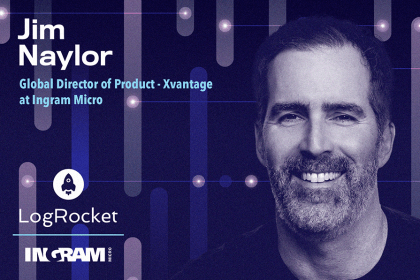
Jim Naylor shares he views documentation as a company’s IP and how his teams should use it as a source of truth.
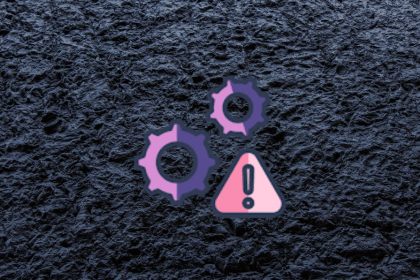
Act fast or play it safe? Product managers face this daily. Here’s a smarter way to balance risk, speed, and responsibility.
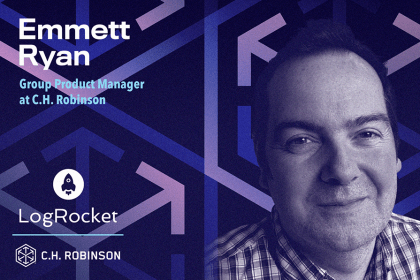
Emmett Ryan shares how introducing agile processes at C.H. Robinson improved accuracy of project estimations and overall qualitative feedback.

Suvrat Joshi shares the importance of viewing trade-off decisions in product management more like a balance than a compromise.